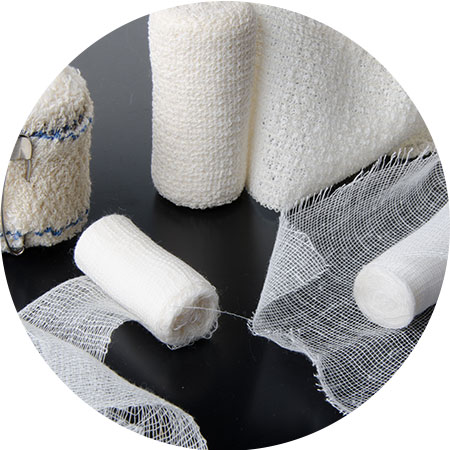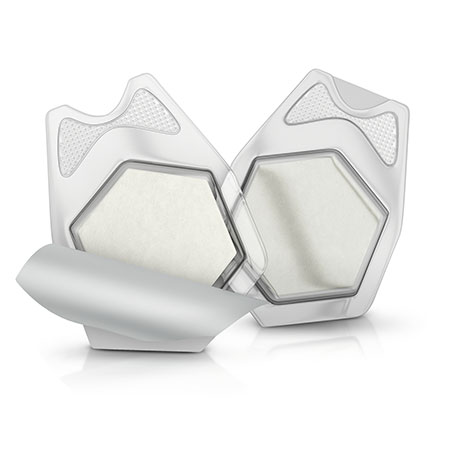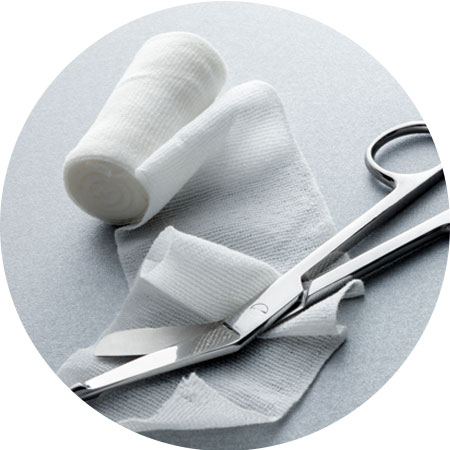
Traditional Woundcare Dressings
Traditional wound dressing products are used most often as primary or secondary dressings to protect the wound from contamination. These products include gauze, lint, plasters, bandages (natural or synthetic), and cotton wool.
Common types of traditional wound dressings include:
- Bandages
- Body Netting
- Cohesive Wraps
- Composite Dressings
- Impregnated Gauze
- Gauze
- Non-adherent Dressings
Advanced Wound Dressings
Advanced wound dressings are typically prescribed by clinicians after a visit to a doctor or hospital. The benefits of using advanced wound dressings include shortened heal time, optimized drainage and reduced risk of infection.

Calcium alginate dressings are highly absorptive fiber dressings made from brown seaweed. They form a gel when mixed with the wound drainage. This natural gel helps to speed up the healing of the wound in promoting the wounds autolytic debridement, while also absorbing excess fluid. They are available in sheets and ropes may contain silver which helps reduce the amount of bacteria in the wound bed. They are meant for wounds that produce moderate to highly exudate. They will need a secondary dressing to keep it in place. They can be changed as often as daily, depending on the amount of drainage in the wound.
HOW TO APPLY:- Cut the dressing to fit in the wound.
- Apply the dressing in direct contact with the wound.
- Cover the alginate with a secondary dressing as directed by your doctor, such as gauze and tape, foam or a composite dressing.
- When applying an alginate rope into tunnels, do not over fill or stuff the wound.
Collagen dressings are derived from animal source, such as bovine (cattle), equine (horse) or porcine (Pig) and should not be used by persons who are allergic to these. Collagen helps to promote the growth of new collagen at the wound site, which may speed the healing process. Collagen dressings can come as gels, powders, pastes and even as freeze-dried sheets that can be placed on wounds. Typically, collagens are changed anywhere from 1-7 days depending on the product and amount of drainage.
HOW TO APPLY:Collagen sheet:
- Cut the dressing to fit in the wound bed.
- Apply in direct contact with the wound.
- If needed you may dampen the dressing with saline.
- Apply a secondary dressing ad =directed by your doctor.
Gels:
- Apply a liberal amount to the wound base and cover with gauze or a secondary dressing as directed by your doctor.
- You may also apply the gel directly to the gauze and then place it in contact with the wound surface.
Composite dressings combine two or more layers of material into a single dressing. These can function as either a primary or a secondary dressing on a wide variety of wounds and may be used with topical medications. Most come with adhesive borders and in multiple sizes. Some provide a bacterial barrier to the wound base. These dressings are versatile and convenient offering options for shallow and deep (partial and full thickness) wounds.
HOW TO APPLY:- Remove all packaging.
- Pull back the plastic strips just like you would on a large Band-Aid.
- Apply over the wound
Foam dressings are designed to create a moist environment conductive to wound healing. These are made of water resistant polymers (generally polyurethane) which absorb moderate amounts of wound drainage. They are typically non-adherent and allows water vapor to enter but keep out bacteria and other contaminants. Foam dressings can be changed as often as every three (3) days.
HOW TO APPLY:- Remove all packaging.
- Apply the foam in direct contact with the wound
- If the foam has a secondary cover this will always go on the outside.
- If the foam has an adhesive border, gently press this down on the skin.
Honey dressings are made with medical grade honey. They come in multiple forms such as gels, gauze and fibers. They provide moist wound healing which will help with wound debridement and help reduce bacteria in wounds.
HOW TO APPLY- Apply the honey onto the gauze and place in the wound bed.
- You may also place a thin layer of the honey in the wound base and cover with gauze.
- Cover the gauze with a secondary dressing.
Hydrocolloid dressings are often the preferred choice when dealing with extra dry wound sites. These dressings create a moist environment to support the body’s healing process and aid in the removal of nonviable tissue from the wound without damaging new tissue. They generally only absorb a small to moderate about of drainage. Typically, may be left in place from 3-7 days.
HOW TO APPLY:- Remove the plastic from the dressing
- The sticky side of the dressing lays down over the wound
- The dressing should be at least 1 inch larger than the wound.
- Press it down over the wound bed
Gelling fiber dressings absorbent wound covers that help manage drainage and turns the fluid from the wound into a gel when moist, which assists in maintaining a moist environment for optimal wound healing and the formation of granulation tissue. They come in many sizes and shapes, including ropes for tunnel wounds and are available with or without silver. Hydrofiber dressings can be changed as often as daily, depending on the amount of drainage.
HOW TO APPLY:- Cut the dressing to fit in the wound.
- Apply the dressing in direct contact with the wound.
- Cover the alginate with a secondary dressing as directed by your doctor, such as gauze and tape, foam or a composite dressing.
- When applying an alginate rope into tunnels, do not over fill or stuff the wound.
A Hydrogel dressing is a sheet or gel composed of mostly water, mixed with polymers. Typically, this will donate moisture to the wound bed. This dressing is used not just for painfully dry wounds and lesions, but also frequently enlisted when treating low-level burns, radiation skin damage, severe scrapes and partial or full-thickness lesions. These are non-adherent, trauma free dressings, often relieving the pain of other dressing choices. They are not recommended for heavily draining wounds. They may require a secondary dressing. These dressings are generally changed every 1-3 days.
HOW TO APPLYYou may use this product in one of two ways:
1. Apply a thin layer (about nickel thick) of the gel in the wound base and cover it with gauze or another secondary dressing.
2. Apply the gel onto the gauze, and then place the gauze down in contact with the wound. Cover with a secondary dressing and tape down
Sheet Hydrogel:
- Remove all packaging.
- Apply the sticky side down over the wound.
- The edges should extend at least 1 inch beyond the wound.
- You will need to use a secondary dressing or need to tape down the edges.
Impregnated wound dressings are gauzes and non-woven sponges, ropes and strips saturated with a solution, an emulsion, oil or some other agent or compound which promotes wound healing. Some example of these impregnated dressings are:
- Hypertonic Saline Gauze – Typically indicated for exudate absorption for cleaning wounds. This is usually changed daily and may result in some tissue destruction.
- Iodine Impregnated Gauze - Used for tunnel wound with foul discharge. This is usually changed daily. May cause tissue destruction.
- Petrolatum Impregnated Gauze - Helps wound protection and wound hydration. Recommended to change every 2 to 4 days. Particularly effective in extremity skin tears.
Multi-layer wound covers which combine a semi or non-adherent layer with a highly absorptive layer of fibers, and are specifically designed to minimize adherence to the wound and effectively manage exudate. They may be used as a primary or secondary dressing,
HOW TO APPLY:- May be applied as primary dressings directly to the wound base or as secondary dressings over a primary wound dressings.
- These are used on wounds that have a large amount of drainage.
- They may be used under compressions wraps.
- Manufacturer’s directions will tell you if there is a particular side that should be placed down on the wound.
Transparent Film
Transparent Film a thin, see thru dressing generally made from polyurethane. They do not absorb any drainage, but will allow a small amount of fluid to pass through it by a process called Moisture Vapor Transfer. They are impermeable to water and bacteria.
- Remove all packaging.
- Pull the backing off of the dressing and apply the sticky side down over the wound.
- There should be at least a 1 “border extending beyond the wound edges.
- If there is another layer of paper attached, gently remove it. Do not over stretch the dressing. It should lie flat on the wound.
Explore our Wound care Education
Along with our product offerings, our product catalogs offer valuable insurance coverage and educational information.
Visit Our Online Wound Care Catalog Learn More














